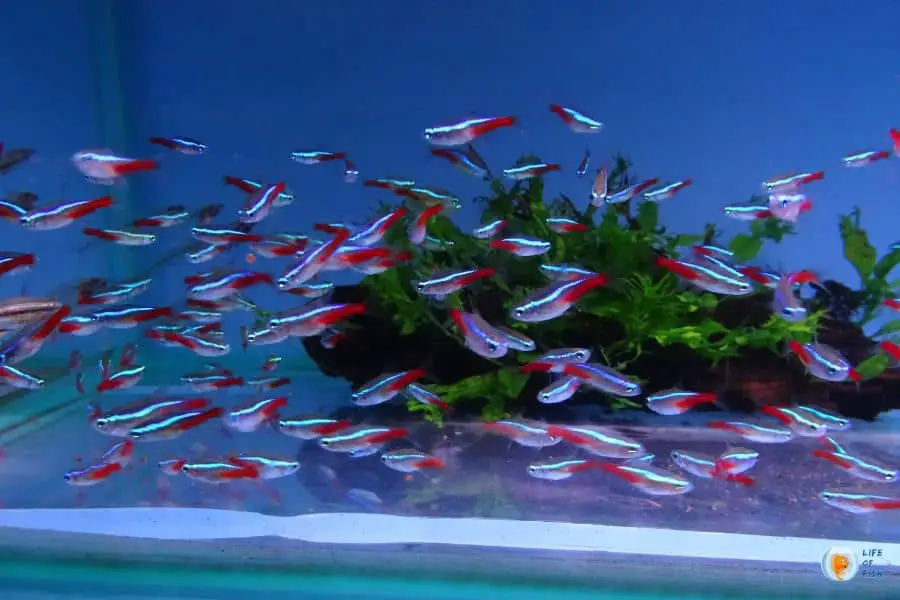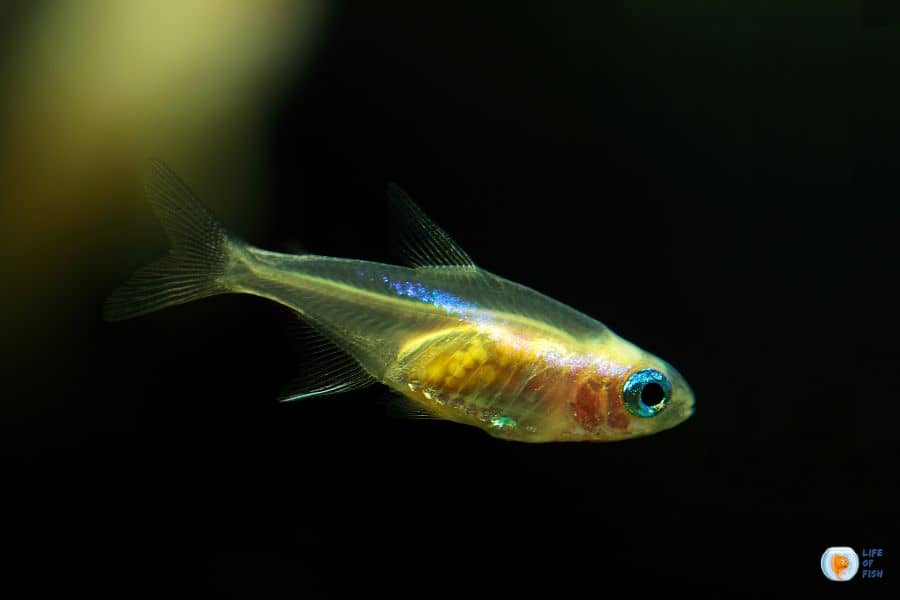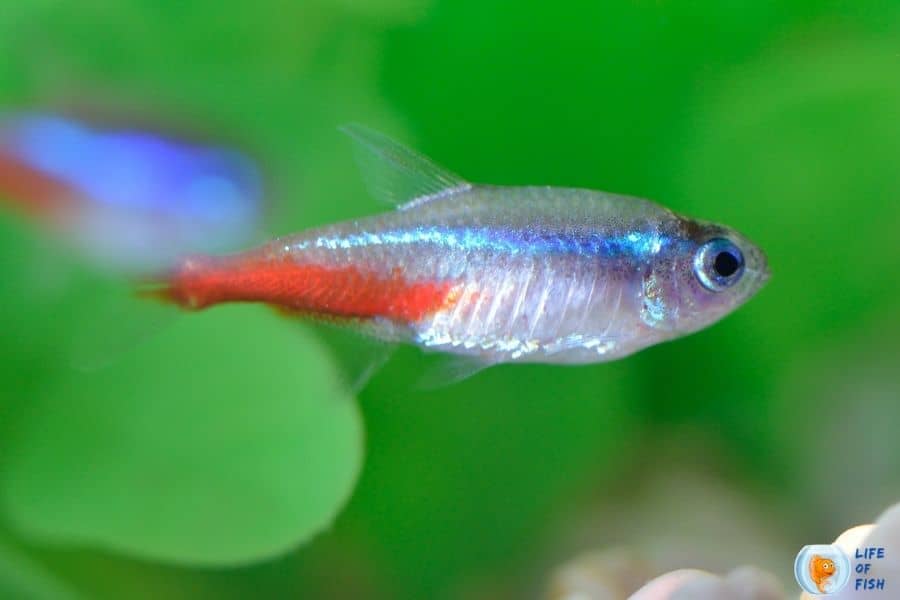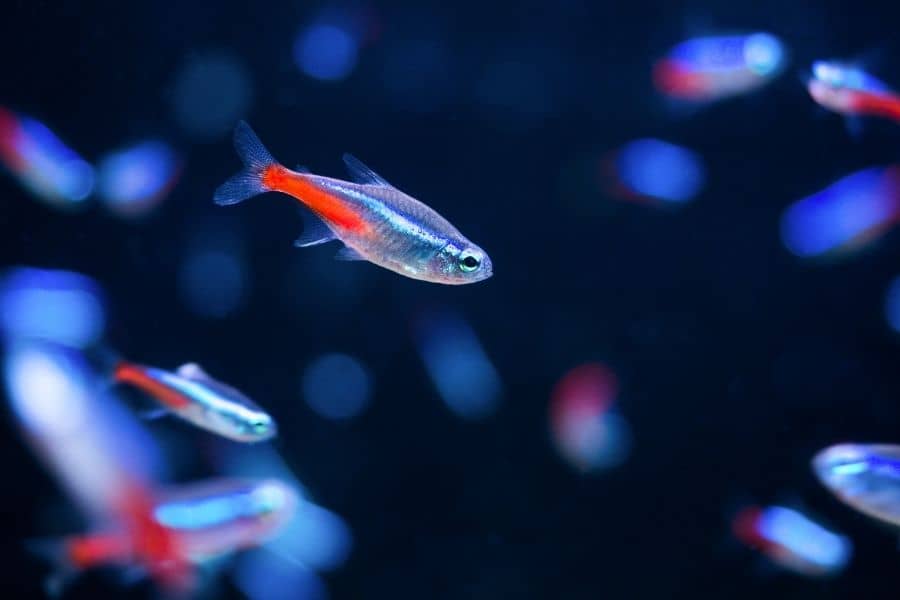To successfully breed neon tetras, one must delve into the specifics of neon tetra breeding, ensuring all breeding requirements are meticulously met.

Understanding Neon Tetra Breeding Requirements
Jump To
Neon tetras, or Paracheirodon innesi, are a popular freshwater fish species, known for their vibrant, iridescent blue and red colors that add a dash of neon to any aquarium setting.
Breeding neon tetras can be a rewarding experience for aquarium enthusiasts, but it does come with its own set of challenges.
The journey to breed neon tetras begins with selecting a healthy pair or group of adult tetras that showcase the right signs of readiness for breeding. I
t’s critical that the breeding aquarium mimics the fish species’ natural habitat with precise water parameters, such as temperature, pH, and hardness levels, tailored to stimulate the neon tetras to breed.
The tank setup should also be conducive to the survival and development of tetra eggs and subsequent fry.
When setting up your tank, which is often designated as a breeding aquarium, be attentive to details like the provision of a subdued light setting and a fine-leaved plant or spawning mop where neon tetras can deposit their eggs.
Tanks should be meticulously monitored for ammonia and nitrate levels to ensure that the breeding environment remains pristine and conducive for the fry’s growth.
Maintaining optimal water parameters is paramount— with specific concentration on a controlled water temperature and the overall tank environment to foster the breeding cycle, thus increasing the chance of witnessing a successful cluster of neon tetra eggs hatching.
Neon tetras are a type of fish species that require a period of conditioning before they are ready to breed.
It usually entails a varied diet, rich in nutrients which encourages the neon tetras to begin the breeding process.
The tank itself, as opposed to merely an aquarium, becomes a breeding ground where adult tetras are given the best possible conditions to reproduce successfully.
For successful breeding, neon tetras should be placed in a lightly populated tank, ensuring that each neon has ample space to perform their breeding rituals without stress or interference.
After the breeding dance, which is quite a spectacle to behold, fertilization occurs and the female neon will scatter her eggs onto plants or a designed breeding medium.
From this point onward, the fertilized tetra eggs demand careful attention. Adult tetras often have to be removed post-spawning to prevent them from preying on their eggs, a common occurrence in many breed-friendly tank environments.
In some cases, hobbyists separately incubate the eggs in another tank reserved for neon fry to ensure that none of the young fall prey to adult appetites.
With diligent care, these eggs will ultimately hatch into fry in about 24 hours, emphasizing the swift nature of neon tetra breeding.
The breeding of neon tetras isn’t simply tossing a few neon tetras into a tank and hoping for the best. It’s an art and a science, relying heavily on understanding and maintaining the perfect water parameters and creating an ideal breeding aquarium ecosystem.
While breeding neon tetras may present its challenges, including the meticulous care of tetra eggs and fry, there’s nothing quite as rewarding as witnessing the transformation of tiny eggs into a school of energetic, iridescent neon fry darting through the water in your tank.
Optimal Water Parameters for Breeding Neon Tetras
Achieving success in neon tetra breeding hinges critically on replicating the ideal water parameters that these vibrant creatures are accustomed to in their natural habitat.
It isn’t simply about maintaining the correct temperature or pH; it’s the combined factors providing a stable and conducive environment for spawning.
The mature adult tetras, mated and ready to replicate the species, will look for conditions that closely mimic the dense, shaded streams of their origin.
In the carefully tailored breeding aquarium, water parameters play the quintessential role in stimulating the neon tetra breeding cycle.
For the most effective breeding conditions, the water—being the theatre of life for these fish—should have a slightly acidic pH, which leverages the neon tetras’ ability to thrive and reproduce.
The temperature of the water should be carefully regulated between 24°C to 26°C (75°F to 79°F), creating a warm embrace conducive for the breeding activity.
Peat filtration can be beneficial, as it simulates the tannin-rich waters where these fish naturally spawn.
Pay attention to the hardness of the water; neon tetras prefer soft water, with a recommended hardness of no more than 2 °dGH.
To enhance the chances of neon tetra breeding, one must not only monitor but strategically manipulate the water conditions, dimming the lighting similarly to their shaded home streams, which can encourage the mating process.
Moreover, finding the perfect balance in water circulation is key, as it should not be too vigorous to disturb the delicate process of egg-laying, nor too still that it fails to distribute crucial oxygen and other dissolved gases.
It’s crucial for breeders to use water that is free from contaminants; regular testing and conditioning are essential.
The process may call for multiple water changes to control the levels of nitrates, and ensure the water remains pristine for the health and vitality of both adult tetras and their offspring.
Providing this level of water quality supports the immunity of neon tetras, lowering the stress that can otherwise hinder breeding efforts.
A dedicated breeding aquarium, carefully set with the optimal water parameters, also encourages natural behavior, such as the choosing of the best territory for spawning by adult tetras.
The water in this breeding aquarium should allow for the display of the neon tetras’ iridescent colors, a key element in their mating ritual.
Regular maintenance of these water conditions is elemental for nurturing the fry once they hatch, as their early stages are when they’re most vulnerable to water quality issues.
Let’s not underestimate the transformative potential of the water element in the breeding aquarium.
Maintaining consistent water parameters paves the way for prolific neon tetra breeding, assuring that these striking fish can continue to captivate hobbyists worldwide.
By ensuring that the water remains impeccable in quality with precise parameters, the dream of watching a shoal of neon tetra fry grow into a glittering school becomes a tangible reality, one that Connect Fish Friends can facilitate with expertise and tailored advice.

Preventing Tetra Disease During the Breeding Process
When embarking on the exciting journey of breeding neon tetras, it’s crucial that aquarists prioritize the health and wellness of their fish to avoid the outbreak of tetra disease—a collective term for ailments afflicting these vibrant creatures.
As enthusiasts deepen their understanding of neon tetra breeding requirements, they must also remain vigilant against tetra disease, ensuring their breeding efforts aren’t compromised.
Vigilance starts with maintaining optimal water parameters, which have been previously discussed, as they are paramount for breeding neon tetras and keeping diseases at bay.
Aquarists must continually monitor water quality, as neon tetras are particularly sensitive to changes in their environment.
Tetra disease can arise from poor water conditions, which stresses the fish, making them susceptible to illness.
For this reason, consistency in perfect water parameters is key to successful breeding and disease prevention. The breeding tank should be kept at a slightly lower pH and a higher temperature than the community tank to simulate the neon tetras’ natural breeding conditions.
A common ailment that afflicts breeding neon tetras is Neon Tetra Disease (NTD), caused by a parasitic organism.
Preventing this condition is far more effective than treating it, so a regular schedule that involves quarantine of new tetras and monitoring for unusual behavior or signs of sickness is vital.
When you breed neon tetras, pay close attention to ensure that the fish are lively and exhibit their trademark brilliant colors.
Another aspect of averting tetra disease is a clean environment. A breeding tank should be free of contaminants and debris, which can harbor harmful bacteria.
Frequent partial water changes are advised to keep nitrogen levels in check, as accumulations of nitrate can encourage tetra disease.
Compatibility of fish within the breeding tank is another factor; neon tetras should be matched closely in size to prevent bullying and stress, as these factors can lead to compromised immunity and tetra disease.
Feeding your neon tetras high-quality food is also instrumental in preventing health issues. A balanced diet that includes live or frozen food, along with high-quality flake food, will ensure your neon tetras are receiving adequate nutrition throughout the breeding process.
Be cautious not to overfeed, as this too can deteriorate water quality and contribute to disease risk among your fish.
Nurturing neon tetras is a rewarding experience for any aquarist, and by providing a safe, stable, and clean environment, you’re laying the groundwork for healthy development, successful breeding, and avoidance of tetra disease.
As your neon tetras develop, it’s exciting to witness the proliferation of these mesmerizing fish in their specially curated habitat—a testament to the dedicated care provided.
In conclusion, consistent attention to the health and conditioning of your aquarium’s denizens is essential. By incorporating these practices, the breeding of neon tetras can be a successful and fulfilling endeavor.
Stay faithful to the expertise offered to guarantee your neon tetras thrive, free from the specter of tetra disease, and bless your aquascape with their diminutive but vibrant presence.
Choosing the Right Tank Mates for Neon Tetras
Embarking on the journey of breeding Neon Tetras, it’s essential to consider theo **tank mates** that will share their environment.
Neon Tetras are desirably peaceful freshwater fish known for their vibrant colors and dynamic schooling behavior. In the context of a breeding aquarium, the tank mates you choose should complement the Neon Tetras by not adding stress or competition for resources.
Neon Tetras thrive in a well-maintained tank with stable water parameters, making them suitable companions for a variety of other fish species with similar care requirements.
Optimal tank mates include other small, easygoing pets such as Harlequin Rasboras and Cardinal Tetras, who likewise appreciate the comfort of a densely planted aquarium.
Together, they create a harmonious visual spectacle while ensuring a stress-free environment conducive to the breeding process of Neon Tetras.
It’s crucial to refrain from pairing Neon Tetras with larger, more aggressive species that may prey upon them or disrupt their breeding efforts.
The ideal tank mates should not only be peaceful but should also not compete vigorously for food.
Well-chosen companions will nurture a serene tank atmosphere, allowing Neon Tetras to exhibit natural behaviors crucial for successful breeding.
Consider dwarf corydoras or small rasboras as tank mates that respect the space and dietary needs of Neon Tetras.
Including shrimp in the Neon Tetra breeding tank can be a judicious choice, as many shrimp species like Amano or Cherry shrimp, offer additional benefits such as algae control, without posing a threat to Neon Tetras or their fry.
Shrimp coexist calmly with Neon Tetras, providing a mutually beneficial relationship within the tank dynamics.
It’s important, however, to maintain a level of care that supports the wellbeing of both the shrimp and the Neon Tetras, ensuring a stable and healthy **aquarium** environment.
When considering tank design, remember the inherent nature of Neon Tetras. They are tropical tetra species that appreciate hiding spaces and subdued lighting, which should be mirrored by the chosen tank mates and their respective care needs.
The integration of live plants and soft substrate not only serves the Neon Tetras but also provides a sanctuary for shrimp and other similar companions.
The success of breeding Neon Tetras hinges on maintaining a tranquil and safe tank. It’s not just about the aesthetic pleasure of an intricately assembled aquarium; it’s about creating an ecosystem that supports the life cycle of these delicate pets.
Vigilant **care** of the tank, including regular water changes and monitoring of the water parameters, ensures the habitat remains hospitable for both Neon Tetras and their tank mates, fostering an environment ripe for propagation.
In conclusion, the community within your tank greatly impacts the potential success of breeding Neon Tetras. Always prioritize the selection of non-aggressive, size-compatible tank mates that require a similar level of care, and embrace the quiet coexistence that Neon Tetras necessitate.
By doing so, you’ll ensure that your tank remains a peaceful haven for these cherished pets, allowing them to breed with ease and grace.
Ultimately, harmonizing the needs of Neon Tetras with those of their selected companions will amplify the serenity and beauty of your aquarium, enhancing the experience for both you and your aquatic friends.

The Neon Tetra Habitat: Setting Up Your Breeding Tank
When aspiring to breed neon tetras, creating the perfect breeding aquarium environment becomes the cornerstone of success.
Neon Tetra breeding is a meticulous process that demands an appropriately designed habitat within your tank, specifically geared towards encouraging the breeding cycle.
To replicate the ideal breeding conditions, every factor from water parameters to the tank’s ecosystem must be controlled with precision.
The first step in setting up your breeding tank is to choose an aquarium that is conducive to the process. Neon tetras thrive in a serene environment, so a standard 10-gallon tank can be an excellent starting point for breeding neon tetras.
It’s essential to consider the space requirements of neon tetras during the breeding phase, and while a larger tank can be beneficial, maintaining correct water parameters becomes more challenging as the tank size increases. Remember, the quality of the environment in the tank plays a crucial role in neon tetra breeding success.
Water parameters are the essence of a thriving habitat. Initially, it’s critical to adjust the water temperature between 72-76°F and maintain a soft water hardness, which are optimal water parameters for breeding neon tetras.
Moreover, the pH level should be slightly acidic, ranging from 6.0 to 7.0, to closely mirror their natural environment.
These parameters must remain stable throughout the breeding process, and using reliable equipment for constant monitoring is advisable to prevent any undesirable fluctuations.
Once the tank itself is selected and the water conditions are optimized, the next focus is on developing a suitable environment within the habitat.
This means providing an array of fine-leaved plants or spawning mops where the neon tetras can lay their eggs. It’s also beneficial to use a substrate that mimics the natural riverbeds found in their native habitat.
Adding a dark substrate can help to encourage breeding, as it more closely resembles the environment from which neon tetras originate.
The breeding environment should be kept clean, and measures must be taken to prevent disease during the neon tetra breeding process.
To do this, it’s important to have a stable cycle of clean water through the use of a gentle filter while avoiding strong currents that could stress the fish or disturb the eggs. It’s also advisable to cover the tank to maintain stable temperature and humidity levels.
Additionally, high-quality water conditioning and regular testing for ammonia, nitrates, and nitrites are imperative for maintaining a healthy breeding environment.
When it comes to the selection of tank mates in the breeding aquarium, it’s generally recommended to remove other fish during the breeding period to ensure that the neon tetra eggs are not eaten and to provide a stress-free environment for the prospective parents.
Lone breeding pairs or small groups of neon tetras are the standard for breeding neon tetras to keep competition and aggression at bay.
Creating a dedicated environment for breeding neon tetras involves meticulous care and attention to detail. From the spaciousness of the tank to the precise water parameters and serene environment, every aspect contributes to the overall success of the breeding endeavor.
Whether you’re a neophyte or an experienced aquarist, understanding the subtleties of the habitat requirements is pivotal in the journey to breed neon tetras.
With a well-established breeding tank, you can expect to observe the fascinating journey from spawning to the emergence of fry, ultimately boosting your community with the addition of these vibrant and delicate fish.
Neon Tetra Diet and Feeding: Ensuring Health for Breeding
The cornerstone of successfully breeding neon tetras lies in understanding the pivotal role of diet and feeding. A well-tailored neon tetra diet is essential not just for the health of the fish but also for enhancing their breeding capabilities.
For neon tetras, a balanced diet supports vibrant coloration, robust immune systems, and optimal reproductive health. In the realm of neon tetra breeding, diet transcends mere sustenance—it’s about preparing the fish physically for the rigorous demands of producing healthy fry.
Initiating the process necessitates an understanding of the typical foods that constitute a nutritious neon tetra diet.
High-quality food items are non-negotiable—these tetras thrive on a varied menu that includes brine shrimp, daphnia, and specially formulated flake food designed for maximum digestibility and nutrient absorption.
It’s not just about the food, food, and more food; it’s about the right type and quality of food that covers all bases—proteins, fats, and vitamins.
Feeding neon tetras with such a diet serves as the bedrock of their health. Seasoned aquarium enthusiasts know that the frequency of feeding is a balancing act.
Overfeeding can lead to water quality issues detrimental to both neon tetras and their tank mates. Conversely, underfeeding during the breeding period can result in diminished health and less viable fry.
The motto for feeding should be little and often, ensuring each food particle is consumed and contributing to your fish’s well-being.
Breeding neon tetras demands a heightened level of care, particularly in the diet department. Prior to breeding, conditioning the neon tetras with live or frozen food can lead to increased spawning success.
Such a diet elevates the health of the fish, but it also serves as a catalyst for breeding behavior. It sets the stage in the tank for the magic of neon tetra breeding to unfold.
Speaking of the breeding tank, the environment should be a replica of their natural habitat to stimulate breeding behavior.
A quiet and sufficiently planted tank with subdued lighting is an ideal breeding ground for neon tetras. The tank water parameters must be meticulously maintained—temperature, pH, and hardness—all play a critical role in the breeding process.
Tank hygiene is an often overlooked yet vital aspect; excess food should be promptly removed to prevent the onset of tetra disease during the breeding process.
When the time comes to transition to fry care, remember that the fry are particularly vulnerable and require specialized food that caters to their developing bodies.
Infusoria, followed by newly hatched brine shrimp, are excellent options as they provide the necessary nutrients for growing fry. Adhering to a strict feeding regimen is crucial as overfeeding can be as harmful to fry as it is to adults.
It’s important to note that breeding neon tetras should be approached with patience and dedication. All efforts in fish care, tank maintenance, and a proper feeding strategy culminate to create an environment conducive to breeding.
To foster the next generation of vibrant and healthy neon tetra fry, aquarium enthusiasts must prioritize the interplay of diet, feeding, and overall health.
Connect Fish Friends, by providing expert knowledge and premium products, can be the ally you need in your neon tetra breeding journey.
Trust in the guiding principles of a controlled diet and consistent care, and your tanks will soon teem with the flutter of tiny neon fins.

Identifying Gender Differences in Neon Tetras for Successful Breeding
Embarking on the journey to breed neon tetras requires a keen understanding of gender differences between adult tetras.
Recognizing the male from the female neon is pivotal for successful breeding, as it directly influences your breeding strategy.
In adult neon tetras, females typically exhibit a more rounded belly, which is especially noticeable when they’re ripe with eggs.
Meanwhile, the male neon tetra boasts a slimmer profile, with a straighter blue line than his female counterparts. These gender differences are subtle but crucial; they’re the nuanced details that experts emphasize for breeding neon tetras with precision.
When we talk about breeding neon tetras, a species with vibrant hues and sociable tendencies, understanding sex distinctions in fish becomes all-important. It’s not just about identifying a female neon; it’s about ensuring that the breeding pair is healthily balanced.
For breed neon tetra enthusiasts, the nuances between male and female tetra propel the breeding process forward.
In a breeding scenario, adult female tetras will display a slightly duller coloration compared to the iridescent males, who typically showcase more intense blues and reds to attract their mates.
The art to breed neon tetras extends beyond just distinguishing phenotypical traits. It’s about creating conditions where fish can thrive and exhibit natural breeding behaviors.
With the right set of parameters, these species will spawn, and your aquarium will become a neon nursery. Whether you’re a seasoned breeder or someone just starting to breed neon tetras, paying attention to these gender differences lays the groundwork for success.
We seek to guide you through this nuanced process, providing expertise on how to identify female and male fish, ensuring your breeding efforts don’t go unnoticed.
Intertwining knowledge with experience, the task to breed neon tetras becomes an exciting venture.
As you witness adult tetras flirt and dance in their aquatic ballet, the distinction between male and female neon transforms from theory to practice.
It’s a delight for breed neon tetra aficionados when the female fish, with their fuller shape, are pursued by the relentless males, indicating a high chance of breeding success. The species’ behavior during this time is fascinating, and for those deeply involved in breeding neon tetras, it becomes a passionate undertaking.
We stress that proper care and attention are the cornerstones of breeding any neon tetra species. Factors such as disease prevention and compatibility with tank mates can significantly impact the health of the female fish and the vitality of the eggs she lays.
Our emphasis goes beyond identifying a female neon; we delve into ensuring the adult tetras, be it the female or the male neon, are at their optimal condition before breeding begins.
Observing adult fish for signs of readiness, encouraging spawning with the right diet, and maintaining excellent water quality are all part of the richer tapestry of breeding neon tetras.
Conclusion
In conclusion, gender differences play a central role in the success of breeding neon tetras. For enthusiasts and professionals alike, being able to differentiate between a male and female neon tetra can mean the difference between a flourishing brood and an unsuccessful attempt. Please use this knowledge, empowering you to breed neon tetras with confidence and precision, nurturing the next generation of these beloved species, and contributing to the fascinating diversity of aquatic life we passionately support.
